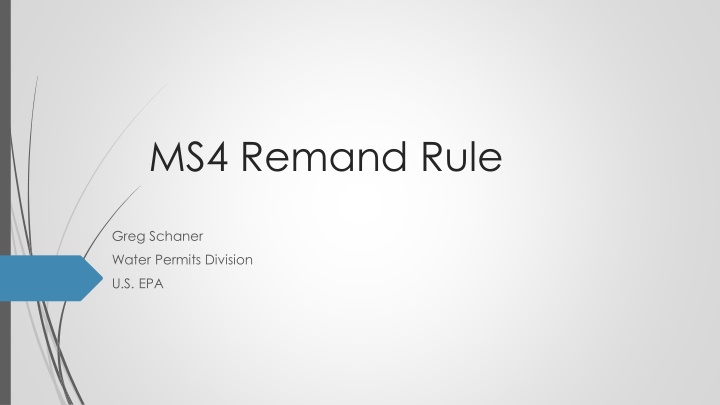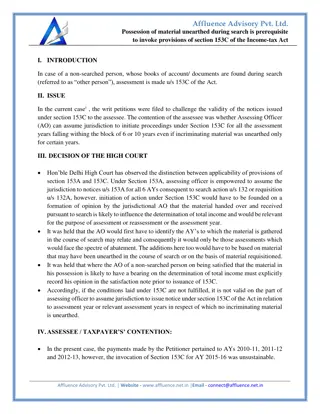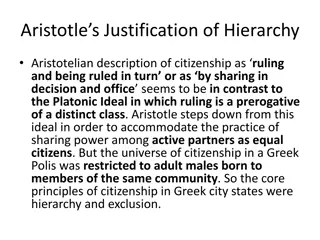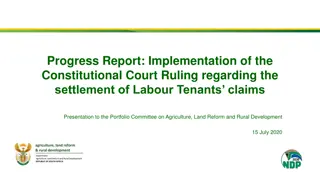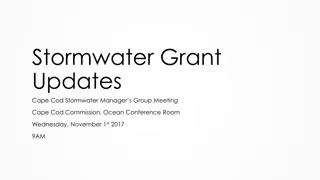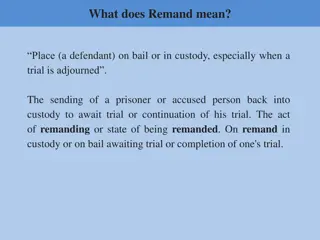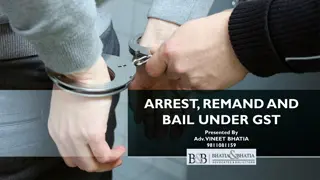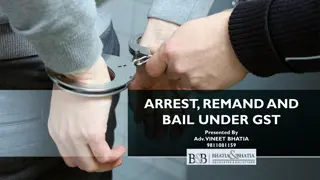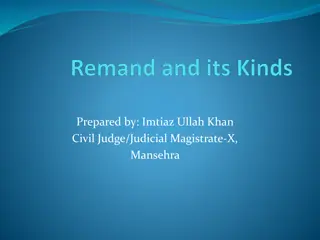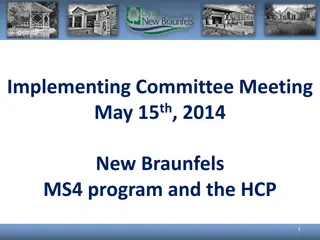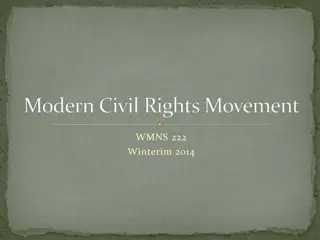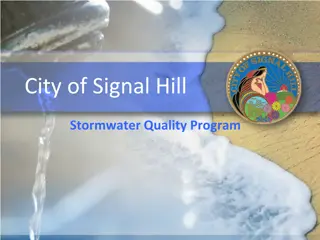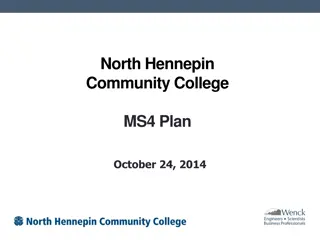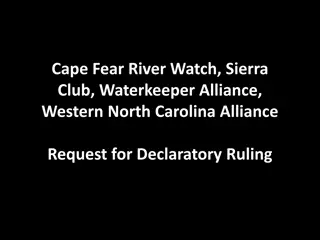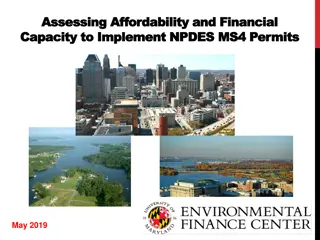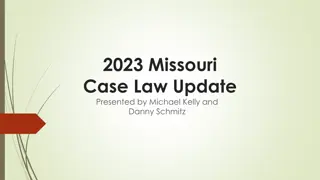Background on MS4 Remand Ruling
MS4 Remand Ruling provides insights into the deficiencies found in Phase II stormwater regulations by the Ninth Circuit in 2003. It highlights the lack of public participation, permitting authority review, and the need for improvements in the permitting process.
Download Presentation

Please find below an Image/Link to download the presentation.
The content on the website is provided AS IS for your information and personal use only. It may not be sold, licensed, or shared on other websites without obtaining consent from the author.If you encounter any issues during the download, it is possible that the publisher has removed the file from their server.
You are allowed to download the files provided on this website for personal or commercial use, subject to the condition that they are used lawfully. All files are the property of their respective owners.
The content on the website is provided AS IS for your information and personal use only. It may not be sold, licensed, or shared on other websites without obtaining consent from the author.
E N D
Presentation Transcript
MS4 Remand Rule Greg Schaner Water Permits Division U.S. EPA
Agenda 2 Provide background on the MS4 remand Discussion: possible scenarios to address MS4 remand Next steps
Background on the MS4 Remand
MS4 Remand Background EDC v. EPA decision (Ninth Circuit, 2003) 4 Focus of the ruling: Ninth Circuit found deficiencies in the Phase II stormwater regulations regarding the procedures to be used for providing coverage to small MS4s under general permits The court vacated the relevant portions of the Phase II regulations, and remanded to EPA to fix the deficiencies: 1. Lack of permitting authority review: In order to receive the protection of a general permit, the operator of a small MS4 needs to do nothing more than decide for itself what reduction in discharges would be the maximum practical reduction. No one will review that operator's decision to make sure that it was reasonable, or even good faith. 2. Lack of public participation in permit process: we conclude that EPA s failure to make NOIs available to the public or subject to public hearings contravene the express requirements of the Clean Water Act.
MS4 Remand Background EPA Guidance 5 2004 Jim Hanlon Memorandum Public Availability of NOIs: Permits should include language how NOIs will be made available to the public with sufficient time to allow for a meaningful public comment Opportunity for Public Hearing: EPA recommendation: include permit language explaining the process for requesting a public hearing on an NOI, the standard by which such requests will be judged, the procedures for conducting public hearing requests that are granted, and the procedures for permitting authority consideration of the information submitted at the hearing Permitting Authority Review of NOIs: Permitting authority needs to conduct an appropriate review of the NOIs to ensure consistency with the permit MS4 Permit Improvement Guide (2010) Revisions to 2002 Memorandum on TMDLs and Stormwater Permits Recommendation that NPDES permitting authorities establish clear, specific, and measurable permit requirements to implement the minimum control measures in MS4 permits
MS4 Remand Background NRDC/EDC petition to Ninth Circuit (2014) 6 Petitioners asked the Ninth Circuit to require EPA to take action to address the 2003 EDC v. EPA ruling Petition requests the Court to order EPA to take the following actions: Immediately revise its Phase II small MS4 regulations include a statement that directs permitting authorities to comply with the 2003 EDC order pending further rulemaking. This action is needed to ensure that state permitting agencies do not continue to mistakenly rely on the vacated rules. Propose within 6 months (and finalize within 6 months after that date) a rule revising the Phase II small MS4 regulations to address the procedural deficiencies found in the Court s 2003 order. Ninth Circuit has given EPA until July 10 to respond
MS4 Remand Background Status of Rulemaking Effort 7 Moving forward with the preparation of a rule proposal Timing of the rule is to be determined by the outcome of the NRDC/EDC petition Major activities: Preparation of rule options/changes to rule language currently considering more than one option for proposal Compiling information on each state s general permit program: How detailed is the permit vs. NOI vs. the stormwater management program (SWMP) How coverage is provided once NOI submitted Is there a waiting period before authorization? Is there a public comment period for NOIs and/or the SWMP, and an opportunity to request a hearing? Are any of the details in the SWMP enforceable as permit terms? Outreach to stakeholders
Discussion: Possible Rule Scenarios to Address MS4 Remand
Discussion: Rulemaking Scenarios Scenario 1: Permit Terms Approach 9 Description (in development) NPDES authority must establish permit requirements that establishes what actions are necessary (including associated deadlines and frequencies) to meet the standard of reducing the discharge of pollutants from [the] MS4 maximum extent practicable, to protect water quality, and to satisfy the appropriate water quality requirements of the Clean Water Act During each permit reissuance, the NPDES authority reevaluates the permit requirements to determine whether they continue to be adequate to meet the standard consistent with the Iterative BMP Approach Each permit will include enforceable requirements that address each of the 6 minimum measures and any more stringent effluent limits necessary to protect water quality More difficult to have permits that only include the 6 MCMs from the regulations without specific, objective, and measurable details defining what constitutes compliance MS4 permittee still required to develop SWMP that describes what BMPs will be selected and implemented to meet the requirements of the permit The SWMP does not contain effluent limits, nor does it modify the terms of the permit Because the enforceable requirements for all small MS4s would be included only within the permit itself, it would be unnecessary to require (1) individual review of each NOI and SWMP (beyond a check for completeness), or (2) public notice and the opportunity for a public hearing for each NOI. NOI could be streamlined to look more like a standard general permit NOI
Discussion: Rulemaking Scenarios Scenario 1: Permit Terms Approach 10 Some State Examples Western Washington small MS4 general permit Public education: each permittee must select from a menu of target audiences and behavior changes, and then measure the understanding and effectiveness of the strategy. IDDE: All Permittees shall complete field screening for at least 40% of the MS4 no later than December 31, 2017, 10 and on average 12% each year thereafter. Construction and post-construction: requirement to comply with minimum technical standards (based on statewide stormwater design manual) Minnesota small MS4 general permit Public participation: Provide a minimum of one (1) opportunity annually for the public to provide input on the adequacy of the SWPPP. Post-construction: The permittee shall develop and implement a Post-Construction Stormwater Management program that requires the use of any combination of BMPs, with highest preference given to Green Infrastructure techniques and practices necessary to meet the following conditions on the site of a construction activity to the MEP: (a) For new development projects no net increase from pre-project conditions (on an annual average basis) of: 1) Stormwater discharge Volume , 2) Stormwater discharges of Total Suspended Solids (TSS), 3) Stormwater discharges of Total Phosphorus (TP)
Discussion: Rulemaking Scenarios Scenario 1: Permit Terms Approach 11 Some State Examples New York small MS4 general permit IDDE: Conduct an outfall reconnaissance inventory addressing every outfall within the urbanized area and additionally designated area within the covered entity s jurisdiction at least once every five years, with reasonable progress each year. For all small MS4s located East of the Hudson River: implement additional MCMs to target phosphorus reduction consistent with the WLA for the TMDL Ex: Develop, implement and enforce a program that ensures that on-site sanitary systems designed for less than 1000 gallons per day (septic systems, cesspools, including any installed absorption fields) are inspected at a minimum frequency of once every five years and, where necessary, maintained or rehabilitated.
Discussion: Rulemaking Scenarios Scenario 1: Permit Terms Approach 12 Some State Examples Vermont small MS4 general permit (TMDL requirements) If MS4 discharges to an impaired water w/ a TMDL, the permittee must develop a Flow Restoration Plan w/i 3 years of discharge authorization, and submit the plan for approval by the state Each plan defines the suite of BMPs to be used to meet the designated flow restoration target The plan must include a construction schedule for installation of the BMPs, which results in full implementation by no later than 20 years after the permit s effective date Once approved by the state, the plan becomes part of the SWMP and enforceable as part of the permit
Discussion: Rulemaking Scenarios Scenario 1: Permit Terms Approach 13 Discussion How would this affect the current way you administer your general permits? Would it change the way you write permits? If you have a public notice process, how will this be affected?
Discussion: Rulemaking Scenarios Scenario 2: Procedural Approach 14 Description (in development) Include requirements for permitting authority review, public notice of NOIs, and providing the opportunity for the public to request a hearing (if necessary) on individual NOIs/SWMPs Permitting authority review NPDES authority required to determine if the NOI/SWMP is consistent with the requirements of the permit, and what (if any) aspects of the SWMP are considered enforceable requirements of the permit Public notice NPDES authority required to provide a public comment period for its finding of consistency and for any additional, enforceable requirements being made part of the permit Must describe process for receiving public comment and considering any comments received Public hearing NPDES authority also required to provide the opportunity for a public hearing on any specific NOI/SWMP, and to describe in the permit how requests for a hearing should be made and considered
Discussion: Rulemaking Scenarios Scenario 2: Procedural Approach 15 Discussion How would this alternative affect the current way you administer your general permits? Do any of you individually review and approve SWMPs when NOIs are submitted? If you provide a public notice process, do you ever receive public comments on individual NOIs or SWMPs? Do you ever require modifications to the SWMPs at this stage, either as a result of public notice or a result of your review? Do you consider the specific details of the SWMPs to be enforceable?
Discussion: Rulemaking Scenarios Scenario 3: Choose Between Scenario 1 or 2 16 Description Rather than selecting one option in the rule, provide for a choice by NPDES authorities among the two different scenarios
